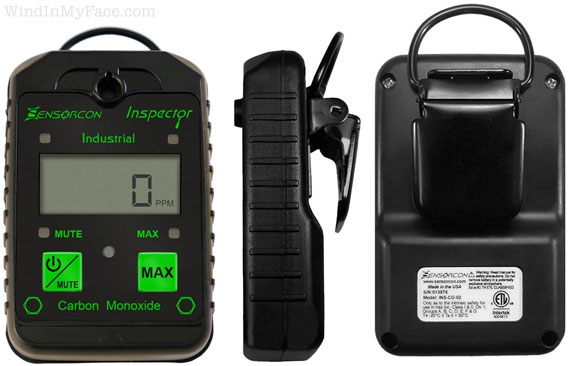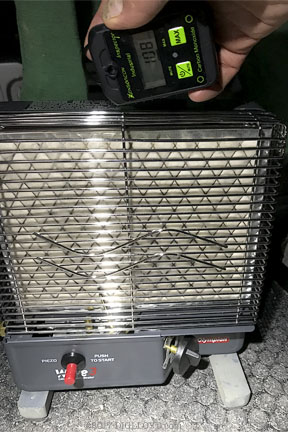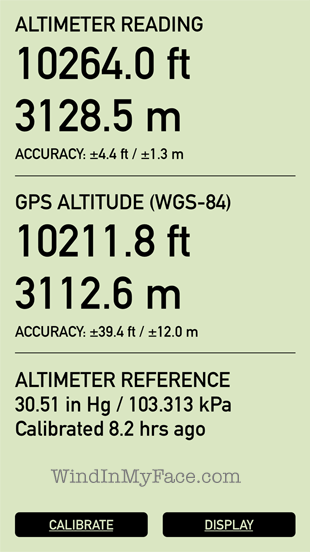Beware all Heaters and Engine Idling: Carbon Monoxide Detectors
Photographer and cyclist and Mac expert and software engineer Lloyd Chambers is available for consulting on general Sprinter considerations at his usual consulting rates via phone, or in person in the Palo Alto, CA area. Save yourself hours and mistakes by discussing issues up-front. More about Lloyd....

I had considered both a diesel heater and a catalytic propane heater for hinting my Sprinter van. Neither is acceptable: diesel heaters won’t function well at high altitude, and a catalytic propane heater marketed as being safe to 12000' / 3657m. But in in fact the heater (two tested) are quite dangerous at the two altitudes I tested at, 6100' and 10200', at least on the high setting.
I’ve settled on electric heating. It is certainly not for most users (10 kW or so needed), but neither propane nor diesel can perform at high altitude (9000' to 11,600'), and there are no health risks with interior electric heating.
Go to sleep and never wake up≠ fun
Carbon monoxide (CO) can kill you, so it’s important to assume nothing about CO emissions and buildup:
- Anything that burns (flame or catalyst) can generate CO.
- ALWAYS have a CO detector on board, preferably two in case one is not working properly.
- High altitude air contains much less oxygen than at sea level. Devices that are safe at sea level may be unsafe at altitude.
- Depending on wind conditions, idling an engine can fill the interior of a vehicle with unsafe levels of CO. Idling for only 10 minutes with favorable wind conditions for dispersal still results in 4 ppm of CO inside the cabin. With unfavorable conditions, levels could go much higher. Measured levels at the tailpipe were seen to be up to 700 ppm—deadly if it infiltrates the cabin.
- Water heaters even if vented can have CO backflow into the vehicle interior via an open window (proven firsthand with an RV water heater).
- Never use a charcoal grill or similar inside a vehicle.
- Never go to sleep with anything that burns fuel—you might never wake up.
- Whether a water heater or interior or exterior heater or engine or whatever is safe does NOT depend on marketing claims, only on reality—measure it.
- Whether a heater or similar is safe today can be different than yesterday or last year.
Bottom line: it is risky to have anything that burns fuel running without having a CO detector. That includes idling an engine. No Sprinter or RV should ever be without a CO detector. Ditto for homes.
For example, a friend’s water heater inside his RV vents to the outside—but if the bathroom window was open, CO had built up to 35 ppm inside! Ditto for diesel heaters and propane heaters that are claimed safe: even if vented to the outside, CO can enter the cabin and build up to unhealthy levels.
Carbon monoxide detector
Playing Russian roulette with CO is foolish. It is why I went with a pro-grade carbon monoxide detector @AMAZON, the CO Inspector Industrial by Sensorcon @AMAZON.
If going a cheaper route, buy at least two—one could fail. The smart move is putting one in living quarters and one near a heater or water heater is wise also—advance warning. But the big problem (seen firsthand) is that cheap consumer CO detectors can take 20 or 30 minutes to let you know of a problem. I observed one such unit read zero for 20 minutes before noticing a problem. The Sensorcon reads CO within seconds, to 1 ppm.
 @AMAZON
@AMAZON
Tough, Waterproof, USA Made: Certified Intrinsically Safe Carbon Monoxide Detector & CO Meter
In testing the Sensorcon CO Inspector Industrial, I found disturbing issues with the Camco Olympian Wave-3 catalytic heaters, as well as other things:
- On high at an altitude of 10,200' at 40°F outdoor temperatures, the Camco Olympian Wave-3 catalytic heaters were seen to be highly unsafe, generating CO levels up to 135 ppm about 5" above the heater, and within 15 minutes generating CO levels of 7 ppm throughout the entire interior of my Sprinter van (after a 10 minute warmup and after venting the van). Operating for an hour would surely raise that level well above 10 ppm and then to much higher levels. It would be highly unsafe to sleep with the heater on, and risky even when awake, since the half life elimination from hemoglobin is 4-6 hours.
- At an altitude of 6100' and on high both the Camco Wave-3 and Camco Wave-7 both generated unsafe levels of CO as measured 5 inches above the heater (in the hot air column). Four to five feet above the heater, levels of 2-3 ppm were seen. The issue is that all that CO rises (hot air) and that CO is lighter than air—a “blanket” of CO will accumulate near the ceiling.
- On low, much lower levels of carbon monoxide were seen.
- A Ford F-350 diesel and 2017 Mercedes Sprinter both generate very high levels of CO, with up to 600 ppm measured at the tailpipe. If that CO wafts back into the cabin, it could be extremely dangerous. Thus engine idling is very high risk without a CO detector.
- An RV water heater emits lots of CO, and with a window open, this wafted back into the RV and unsafe levels (above 35 ppm).
My working theory is that at altitude with the Camco catalytic heaters set to high, there is too much propane for the amount of oxygen that can enter the catalyst pad to fully burn the propane, hence hazardous CO instead of safe CO2. Without propane flow rate regulation that is altitude specific, the same amount of propane is going to flow (perhaps more, due to lower air pressure!). Sufficient oxygen cannot migrate into the catalytic pad to react with the propane fully, hence CO is generated. This makes sense from basic chemistry: the moles of propane vs moles of O2 needed to fully oxidize it.
The Camco claim of “safe to 12000' elevation” appears to be false, based on direct measurement at 6100', tested with both the Wave-3 and Wave-6. Ditto for 10,200'.
Below, the Sensorcon CO Inspector Industrial @AMAZON reads 108 ppm just above the Camco Olympian Wave-3 heater at 10,200' elevation. Readings as high as 135mm were seen.



 @AMAZON
@AMAZON @AMAZON
@AMAZON